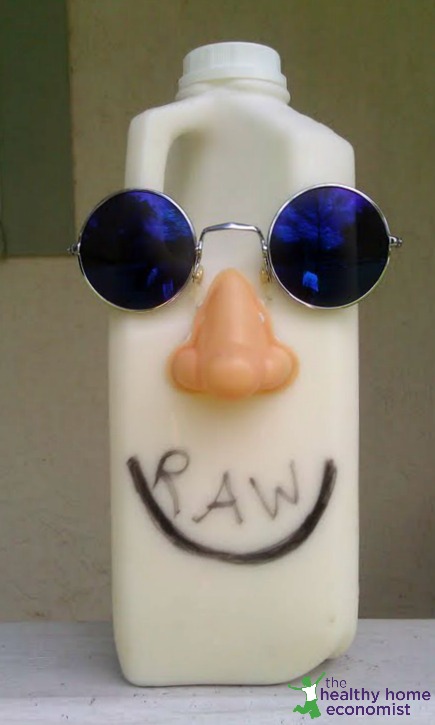 When folks start getting into Traditional Cooking, learning to ferment foods like clabbered milk is a basic skill that must be mastered. Lacto-fermented foods are rich in enzymes as well as beneficial bacteria.
When folks start getting into Traditional Cooking, learning to ferment foods like clabbered milk is a basic skill that must be mastered. Lacto-fermented foods are rich in enzymes as well as beneficial bacteria.
Think of lacto-fermented foods like clabbered milk, sauerkraut or pickles as “super-raw” foods. The enzymes in lacto-fermented foods more than compensate for the enzymes lost in the foods that are cooked when consumed with a meal.
Lactic acid is what is responsible for the magic of lacto-fermentation; it preserves food by inhibiting putrefying bacteria. This organic acid is produced by a beneficial bacterium present on the surface of all plants and animals – even our own skin!
Traditional cuisines from around the world prized lacto-fermented foods and beverages for their medicinal properties as well as delicious taste. Most traditional cuisines included at least one fermented food or beverage with every meal, which worked to improve digestion and nutrient absorption.
Why Clabbered Milk is Important
When embarking on the adventure of lacto-fermentation for the first time, a basic ingredient required by many recipes is liquid whey.
Liquid whey serves as an inoculant and so is of critical value in fermenting vegetables, fruit chutneys and beverages; having some on hand is of primarily importance when incorporating these traditional methods into your routine.
Whey must be homemade and can be easily made by straining the clear liquid from plain yogurt, kefir, or clabbered raw milk through a dishtowel into a bowl. Powdered whey cannot be used as a substitute as whey is very fragile and its qualities are ruined when it is dried or powdered.
Once you’ve got a big jar of liquid whey ready to go from your first batch of clabbered milk, the world of fermenting food is truly your oyster! The whey lasts 6 months in the refrigerator, so it makes sense to make large batches at a time.
You can also make delicious beverages with your clabbered milk. Try a milk clabber smoothie, or a sweet lassi, India’s delicious yogurt-style drink.
I’ve Left the Raw Milk on the Counter for a Week and it Won’t Clabber!
If after following the recipe below, your the raw milk still does not clabber, it’s time to have a conversation with your dairy farmer.
There is likely an issue with the Milk Urea Nitrogen value (MUN), which probably measures 23 or over. A high MUN prevents the raw milk from fermenting into yogurt or even clabbering properly. Cream from high MUN milk will not whip properly either.
This article on evaluating a grassfed dairy farm provides more information.

Homemade Clabbered Milk Recipe
Recipe for making clabbered milk at home which can be used for making homemade fermented foods and drinks loaded with enzymes and probiotics. Makes a great substitute for yogurt in smoothies too.
Ingredients
- 1 quart raw milk preferably grassfed
- 1 Tbl whole milk yogurt optional
- 3 drops lemon juice optional
Instructions
-
Add optional yogurt OR lemon juice to milk container if you need clabbered milk as quickly as possible. Skip this step if your milk is already sour or you are not in a hurry.
-
Shake up milk container vigorously.
-
Leave on the counter for 1-5 days until yogurt like curds form and separate from the clear liquid (whey) portion of the milk. How long this will take depends on the temperature in your home as well as the freshness of the milk. Here in Florida, clabbering typically takes 1-2 days no matter the time of year.
Recipe Notes
When attempting to clabber milk, it is best to use raw milk that is a week old or more. Keep it at room temperature on the kitchen counter and don't try to clabber in the refrigerator.
If your raw milk is very fresh and you don't have time to wait the many days until it clabbers, add the optional a few drops of lemon juice or a tablespoon of yogurt to the container of milk and shake it up. Leave on the counter as usual and it will clabber much more quickly.
NEVER attempt to clabber pasteurized milk even if low temp (vat) pasteurized. It will go putrid if left on the counter and is never safe to consume.
More Information
Sarah, The Healthy Home Economist








I churn butter in a Dazey churn. At times even when the clabber looks good, I can NOT get the butter to come from churning. I have tried letting the churn come up to room temp, have had it right cold, the butter flakes appear but will not coagulate enough to separate from the buttermilk. I know of no use for unsuccessfully churned clabber, other than giving it to the cat or pouring it into a recipe. Any suggestions?
How long will clabbered milk last room temperature or does it need to be refrigerated?
You need to refrigerate it immediately after it is ready on the counter. It lasts several months, but will progressively get stronger in flavor. So, best to use it up within a few weeks.
I am new to clabbering my raw milk. I left some out but after a week realized it was too cold in my home, and only the cream seemed to solidify at the top. Then, I put it in the oven with the light on and it started to smell cheesy but not necessarily bad. Now, about two weeks later, I can see some liquid separation beginning but there are white mold patches on the top. Can I scrape them off or can I drain this to see what I have? I think the last time I tried to make whey I let it separate too long and the “cream cheese” was in hard curdles and very funky… but I kept the whey and used it successfully. Thanks so much!
This is my first time making this, and I think I did something wrong! It does not smell pleasant. It smells kind of musty. Did I let my milk sit out too long? I think I left it on the counter for about two days in a half gallon mason jar. When I woke up this morning, it was completely separated. The curds were all clumped together, almost like a cake the shape of the bottom of the mason jar, and floating in the liquid whey. I proceeded to drain it per your instructions in the video, bundled together in a towel. I tasted it after a few hours. The texture was fantastic, but different than a cream cheese. Its like it had started to form into a soft cheese, and when I pulled it apart, it was almost like a mozzarella. It did not taste good, at all, however.
Help! What did I do wrong? Is any of it still usable?
It is difficult if not impossible to diagnose your problems without seeing it for myself. Clabbered milk has a fermented smell and if you are not used to it, yes it might seem unpleasant because it is different from anything you’ve experienced before. You will have to use your best judgment. If it doesn’t have mold, then chances are it is fine. My suggestion is to make whey with whole milk yogurt first (from the store is fine) to get the hang of it and then move on to clabbering raw milk when you have some experience under your belt. https://www.thehealthyhomeeconomist.com/how-to-make-yogurt-cheese-raw-or-heated/
I stumbled on this blog post while ‘troubleshooting’ my first batch of homemade whey. It’s been sitting on my counter for 2 days and I did see separation. Basically, there is a thick yellow layer at the top and the rest still looks pretty white. The yellow portion almost tastes like butter. I’m not sure if I can still try to get whey out of this batch since I already drained it… Do you think it is because I didn’t let it sit long enough? Any chance it is still usable? I’m wondering if it is more like buttermilk now and if I will be getting whey in the end or if I should start fresh.
Sounds like you drained the whey away. 2 days is about right. If the milk is very fresh or the house is very cool it sometimes takes longer. If you want whey, you probably need to start again and don’t drain it away after it separates … separate it via this method (video included): https://www.thehealthyhomeeconomist.com/video-liquid-whey-and-cream-cheese/
When do I know it is clabbered? IF I wait longer does it become cream cheese? I was reading in the weston price cookbook that you do pretty much the same procedure to make whey and sour cream. So is there a point where you have to stop the fermentation process to be able to drink clabbered milk? When it seperates do I shake it back together and drink it?
You know it’s clabbered when the milk portion of the milk and the solids portion separate slightly. No, it won’t turn into cream cheese … you have to separate out the whey to get cream cheese. https://www.thehealthyhomeeconomist.com/video-liquid-whey-and-cream-cheese/
My grandmother made clobber milk from powdered milk can you tell me how she did it . Thank you very much
Here’s how they make commercial milk powder. Hope this helps. https://www.thehealthyhomeeconomist.com/milk-powder/
Real buttermilk, left over from mechanically making butter from cream, is not fermented. Buttermilk sold in the stores today is made from a culture.
Why can’t milk be clabbered in the fridge? Is it unsafe? Or does it just take longer? I can’t find an answer to this question anywhere. When I get busy sometimes my raw milk has already separated into curds and whey in the fridge? Is this still useful??? Can I make homemade cheese??? I’m new to traditional foods and I am puzzled that no one has answered this very basic “why”.
You can clabber raw milk in the fridge, it just really slows the process down and can take a very long time.
All I have is pasteurized milk. I added a tiny bit of fermented sauerkraut. After a couple of days, it separated into whey and clabber, but wasn’t at all sour. Any thoughts, anyone?
Do not consume this! It is putrid and can case food borne illness. You CANNOT clabber pasteurized milk. It is a dead food. What you can do is take pasteurized milk and culture into yogurt or kefir using the proper starter culture and method.